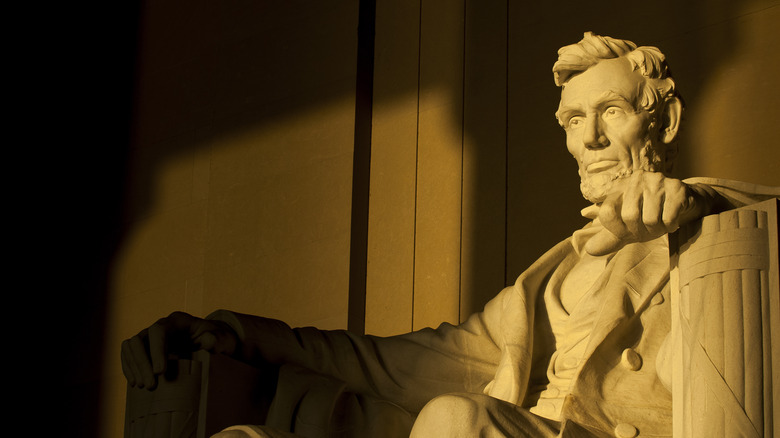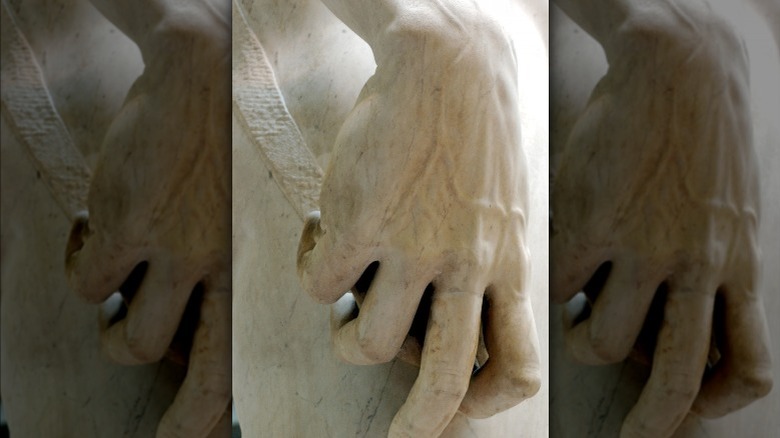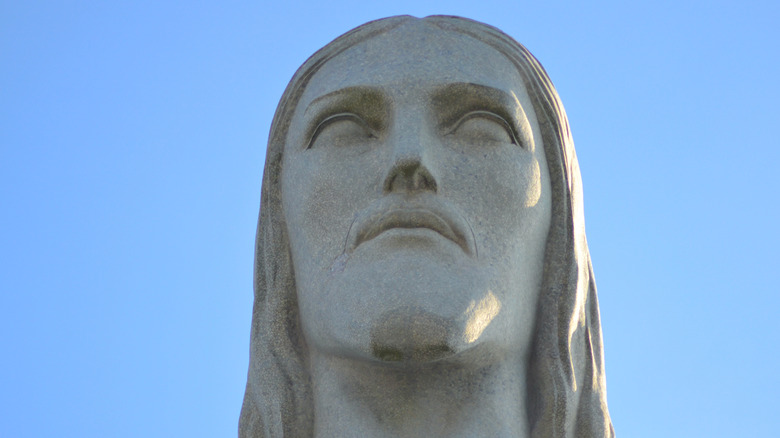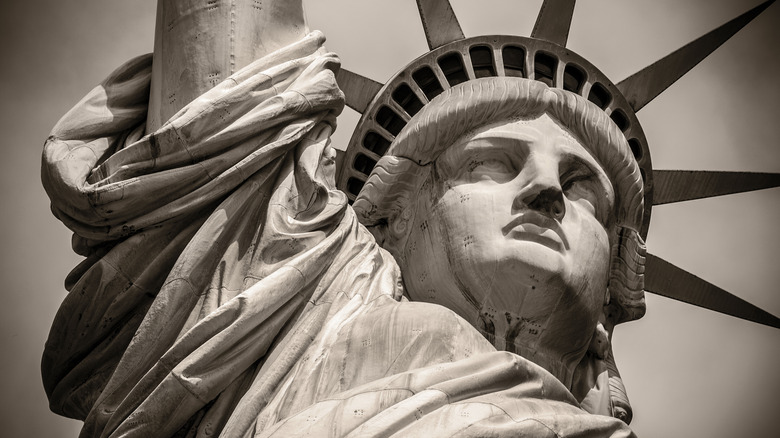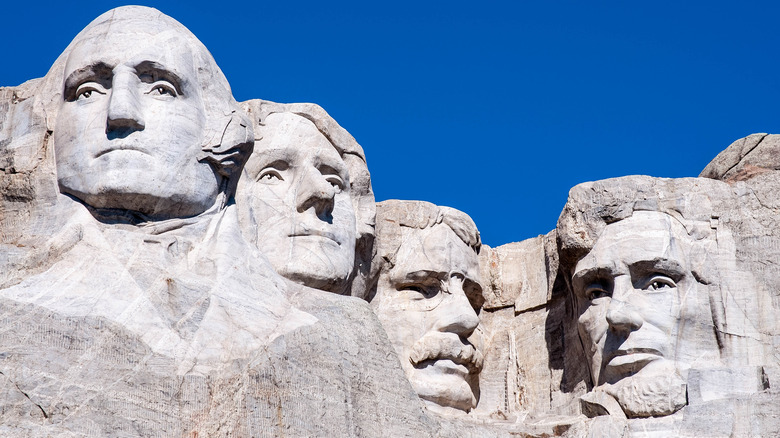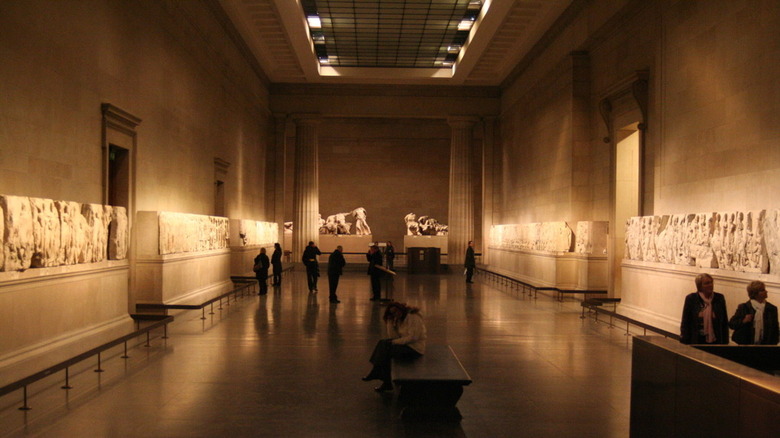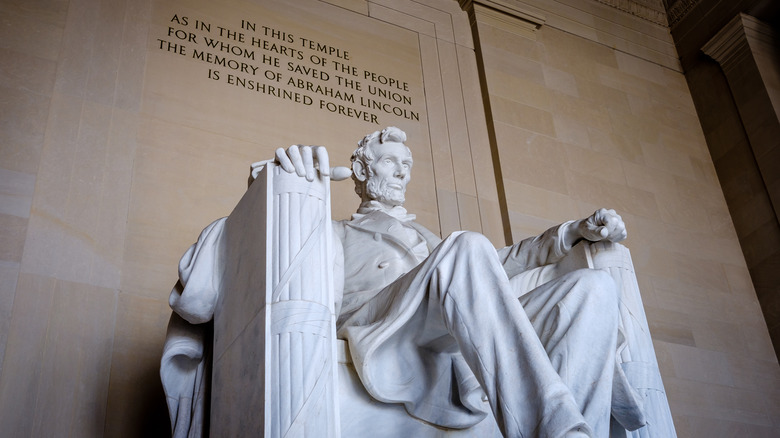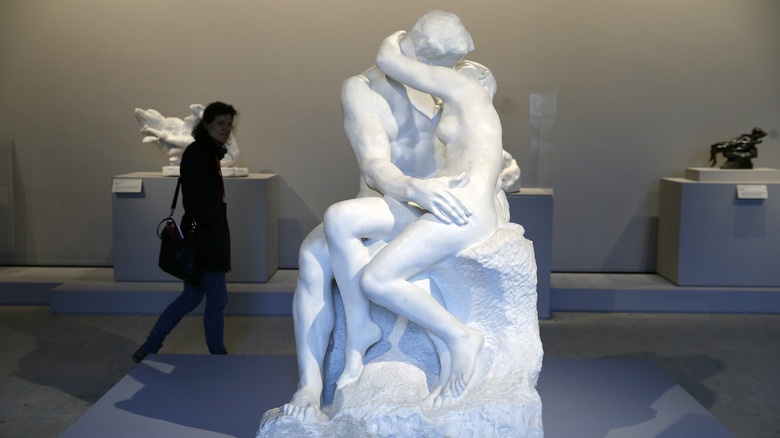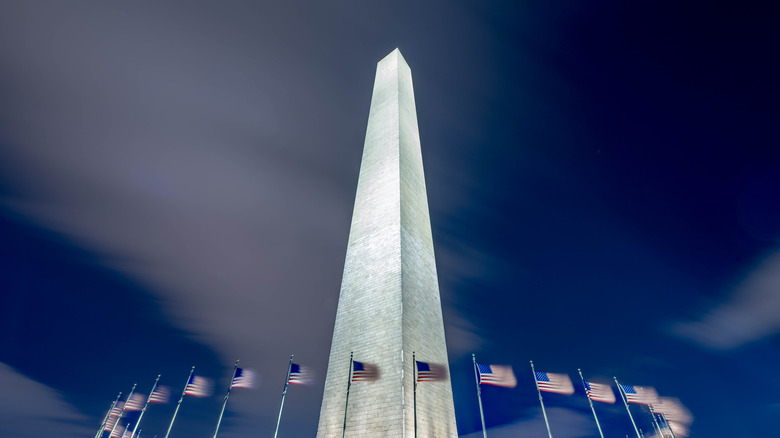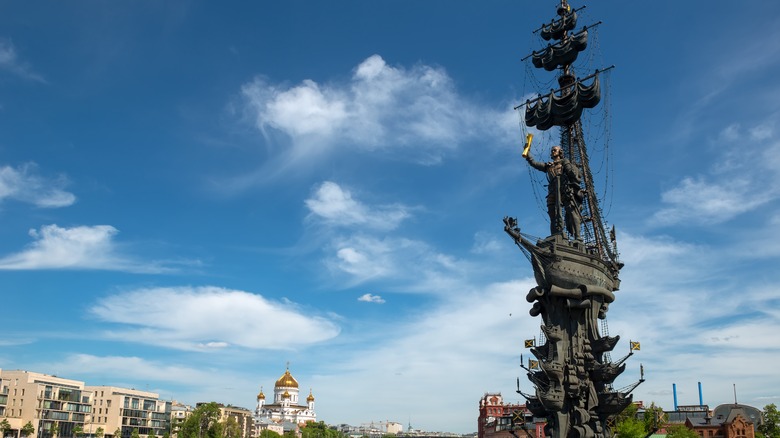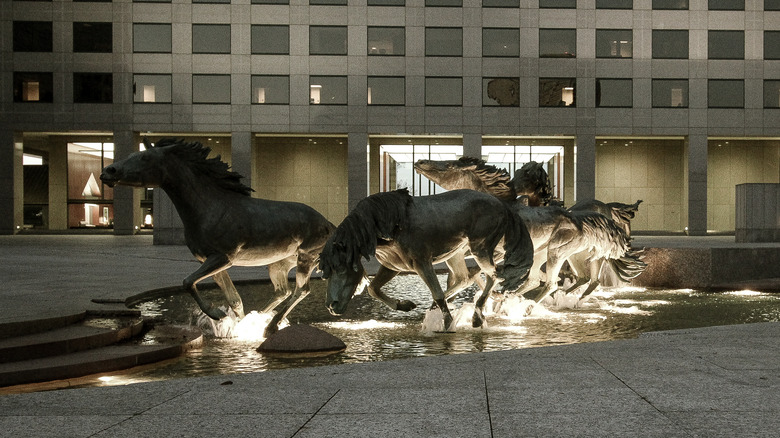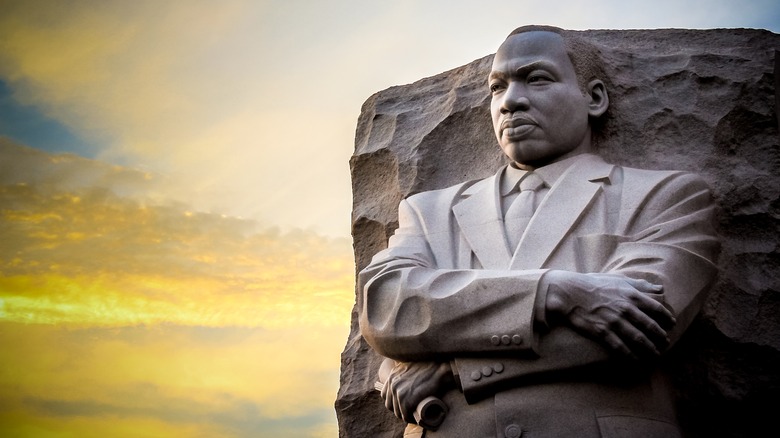Secret Messages Hidden In Famous Statues
The world's most famous statues have stood the test of time and encapsulate ideas about the legacies (whether right or wrong) of the cultures who created them, per The New Yorker. They've also become iconic in their own rights, readily recognizable due to their continued presence in pop culture. In other words, they retain currency despite the passage of decades, centuries, or even millennia in some cases.
Because of our familiarity with these symbols, you might assume there's little left to learn about them. After all, the most celebrated ones, from Michelangelo's David to Frédéric Auguste Bartholdi's Statue of Liberty, receive airtime in classrooms across the United States and around the globe. They appear in television shows and movies, history documentaries, and pop culture kitsch, from funny memes to fridge magnets, t-shirts, and greeting cards.
But a treasure trove of secret messages remains hidden within some of these artistic representations. There are many reasons for the existence of these clandestine communications, from strategic design elements to touches added by workers employed to bring these monuments to life. Keep reading for a new perspective on some of the planet's most renowned statues. Without a doubt, you'll never look at these masterpieces the same way again.
Michelangelo's David
Michelangelo's 17-foot-tall statue entitled "David" remains one of the most famous artworks on the planet, per NBC News. It shows the shepherd David preparing to go into battle against Goliath. Some scholars now believe the statue includes a hidden weapon barely visible in his right hand. Known as a fustibal, it proved devastating on the battlefield, capable of delivering a projectile up to 600 feet.
While a controversial theory, other Renaissance masterpieces may support this conclusion. For example, a handful of Leonardo Da Vinci's sketches depict fustibals, as does the east portal of the "Gates of Paradise" by Lorenzo Ghiberti. Interestingly, in Ghiberti's work, the fustibal is in the same panel as the story of David and Goliath. This placement has led some art scholars to believe that Michelangelo received his inspiration from these Baptistry doors.
Besides a hint of high-tech weaponry, Cardiologist Daniel Gelfman recognized something unusual while viewing the statue in Florence, per USA Today. On the right side of David's neck, he noticed a bulging vein. In patients, it's a sign of late-stage heart disease, known as jugular venous distension (via JAMA Cardiology). This made him ponder why Michelangelo would include it in the depiction of a healthy young man. After returning home and taking an art class, he realized the protruding vein suggested extreme, though temporary, excitement in the face of impending battle. Likening it to the way people flush with emotion, Gelfman has come to appreciate the tension it implies.
The Christ the Redeemer Statue
Brazil's Christ the Redeemer is considered one of the New Seven Wonders of the World, but there's more to this statue than meets the eye. Completed in 1931, it stands 98 feet tall and boasts an arm span of 92 feet (via Britannica). Constructed of reinforced concrete, the surface of the statue appears completely smooth from a distance.
But when you get up close, you can see that it's covered in more than six million small triangular soapstone tiles, according to Mental Floss. These tiles measure 1.2 inches by 1.2 inches by 1.4 inches and are a mere 0.20 inch thick, as reported by the BBC. Female volunteers glued these pieces to linen cloth squares, working at parishes located in the shadow of Corcovado. While they worked, the women often stopped to write well wishes and messages on the soapstone. Some women scrawled their names or those of loved ones, securing a small piece of immortality.
Lygia Maria Avila da Veiga, one of the women who worked on the statue, reminisces, "I wrote many wishes on the soapstones ... They are up there, up there on top" (via the BBC). Legend says all the women of Brazil worked as volunteers on the statue, reports Atlas Obscura. Like da Veiga, they left their stories with Christ the Redeemer, a fitting national patchwork worthy of Brazil's most emblematic monument.
The Statue of Liberty
Since 1886, Lady Liberty has welcomed people to New York Harbor, per the National Park Service (NPS). But few people notice the statue's feet. The figure stands amid broken shackles. Although the story behind this symbology gets overlooked today, it's vital to American history, and it starts with a man named Edouard de Laboulaye.
A noted French political thinker, Laboulaye was also an expert of the United States Constitution, an abolitionist, and a diehard fan of President Abraham Lincoln. With the end of the Civil War and the abolition of slavery, Laboulaye came up with a great idea. He proposed sending a gift to America from France, commemorating the end of slavery. In other words, the Statue of Liberty's original intent was a celebration not of immigrants to the nation but freed slaves (via The Washington Post).
Despite the good intentions, it proved hard for many Blacks in America to get behind a statue celebrating their freedom when injustice remained so rampant. The Black Press reminded the world that discrimination and injustice had not ended with the Civil War, per the NPS. And W.E.B. Du Bois noted that he couldn't feel the same sense of joy looking at the Statue of Liberty as immigrants heading to America. For these reasons, America's Black communities never enthusiastically embraced the national monument, and its original meaning faded into the pages of history.
Mount Rushmore
If you're a fan of "National Treasure: Book of Secrets," then you already know South Dakota's Mount Rushmore contains a hidden chamber. Located behind Abraham Lincoln's hairline, per the National Park Service (NPS), it proves a little less dramatic than the movie version, though. According to History, the room measures 75 feet long by 35 feet tall with an 18-foot-tall entrance.
The doorway looks like the gateway into an Egyptian tomb, and researchers say Mount Rushmore's sculptor, the Danish-American Gutzon Borglum, created it as a receptacle for his "artist's statement." This statement would greet future generations and even "interplanetary visitors" to the site well into the future. Dubbed the "Hall of Records," Borglum envisioned it relaying the story of America's first 150 years of history through treasured artifacts, including the Declaration of Independence.
The sculptor explained, "On the walls of this room should be cut the literal record of conception of our republic." But Borglum died in 1941 after 14 years dedicated to the monument, and the "Hall of Records" remained unfinished (via Business Insider). Borglum's family petitioned the government to complete his vision, and work began in 1998. They added porcelain tablets explaining the work done at the monument and essential documents. But don't expect to see Mount Rushmore's hidden messages anytime soon. Sealed in a titanium vault, the "Hall of Records" remains inaccessible to tourists today.
The Parthenon Marbles
Created around 447 B.C. and moved to England in 1802, the Parthenon Marbles contain a long frieze of relief sculptures depicting various scenes from the Ancient Greek world, according to the BBC. But one key vignette still arouses plenty of debate due to a potential hidden message. The segment of bas-relief in question shows a child presenting a folded cloth to an adult. While it looks innocent enough, think twice.
Some scholars claim it depicts the King of Athens' daughter presenting her burial shroud to her father before getting sacrificed to the gods. This interpretation would remain unconfirmed until an unlikely discovery made in Egypt involving the mummies of everyday people (via the New York Post). Unlike the bodies of pharaohs preserved with great finery, regular people's corpses got wrapped in recycled papyrus. Some of this re-used paper contains lost fragments of the play "Eretheus" by Euripides.
The lines describe an early king of Athens who sacrificed his youngest daughter during a "barbarian invasion" to save the city at the behest of the Oracle of Delphi. Joan Breton Connelly of New York University deciphered these Greek fragments and notes, "[I realized that] Euripides was talking about what you see in the middle of the Parthenon frieze. It's a family group — a mother, father, and three girls — and they're preparing to sacrifice the littlest girl." But Connelly sees an even deeper message: no one, not even the king of Athens, was above sacrificing all to preserve democracy.
The Lincoln Memorial
Rumors swirl around the Lincoln Memorial in Washington, D.C., and its shrouded symbols, per the National Park Service (NPS). Some of these messages remain overt, while others are up for debate. Some people see Jefferson Davis' image concealed in Lincoln's hair. Others say Abraham Lincoln's hands form his sign language initials "A" and "L." The controversy over hidden messages inspired the NPS to create a "Lincoln Memorial Myths" page to debunk the most egregious of these claims.
The NPS asserts the hair rumor is false. Instead of seeing something carved into the President's coiffure, it's a simple case of pareidolia, or the tendency of humans to see faces in everyday objects, per the BBC. As for Lincoln's hands, they aren't communicating via sign language, although the sculptor of the statue, Daniel Chester French, did incorporate this language into another of his works. (The NPS believes this may be why the rumor emerged in the first place.)
Despite all this debunking, however, the statue of Lincoln does contain a clandestine message that most people don't get at first (or even second) glance: fasces. The NPS explains fasces were "bundle[s] of rods ... bound by a leather thong," and closer observation reveals them hidden (in plain sight) on the throne where Lincoln sits. A symbol from ancient Rome, fasces represented "executive authority." Since Abraham Lincoln effectively acted as the leader of the Executive branch of government during his presidency, the fasces offer the perfect nod to his role in U.S. history.
Auguste Rodin's The Kiss
Rumor once had it that Auguste Rodin's "The Kiss" received inspiration from the sculptor's real-life love affair with one of his students, Camille Claudel, per the BBC. But Rodin began this iconic work before ever meeting Claudel. To find the real spark that ignited this work of art, then the investigation must go to the medieval past and the literature of epic poet Dante Alighieri.
In the "Inferno" from his "Divine Comedy," Dante described the adulterous love affair between Paolo and Francesca and the punishment they endured as "carnal sinners, who subjugate[d] reason to desire" (via Digital Dante). By taking this stance, Dante opposed "courtly love" (or the celebration of adulterous love) in its consummated form. The depiction of the wind-tossed lovers, thrown about in death the way passion whipped them about in life, marks one of the poem's most dramatic and memorable episodes.
Musée Rodin notes that Rodin provided no qualifying description when he first exhibited this sensual sculpture. So, audience members had no reference point for Dante's poem. Instead, they referred to it as "The Kiss." But the hidden messages don't stop there, per Art Fund. Besides the vaguest allusion to Dante's lovers, the couple's lips remain suspended and untouching, caught in the moment before the act of adultery that condemned them both to hell. It's as if Rodin is saying sin begins with intention. The audience is left to fill in the blanks (as they do) of the mere suggestion of a kiss.
The Washington Monument
It's hard to keep track of all the so-called Masonic conspiracies surrounding Washington, D.C., and its monuments, per The Washington Post. Among the most speculated-about monuments remains the Washington Monument. While some of its symbology can be seen with the naked eye, one message is concealed 555 feet above the ground: an aluminum pyramid capping the monument (via "Topping Off the Tip").
According to ASM Historical Landmark, the pyramid measures nearly 9 inches tall and 5.6 inches at the base. It weighs a total of 100 ounces, the largest aluminum casting of its day. If you're wondering why the monument's creators chose aluminum — a mundane metal used to cover food — you're not alone. But remember, in 1884, aluminum still proved rare and expensive. Its use on the tip of the Washington Monument represented a calculated move to illustrate the metal's usefulness in an engineering setting. What's more, aluminum doesn't tarnish, and its color complemented the rest of the monument.
Besides the aluminum capstone, obvious and inescapable parallels between the Washington Monument and architectural symbols from ancient Egypt exist. These conscientious similarities evoke "the timelessness of ancient civilizations." But the hidden messages don't stop there, according to the NPS. Engraved on the metal tip, you'll find notable dates and names. On the east face of the monument, which aligns with the rising sun, the Latin phrase "Laus Deo" (meaning "Praise be to God") is engraved.
The Peter the Great statue
The Peter the Great monument in Moscow is one of the most hated statues in the world and has made numerous "ugliest statue" lists, according to Atlas Obscura. Something is fitting about this, considering Peter the Great's despicable deeds. During one of his low points, he had the tsarevich of Russia, his eldest son, tortured to death, per History. At this point, you may be wondering why anyone would want to commemorate him at all — no doubt a valid point.
But Peter the Great did do some "great" stuff, as his name suggests, including establishing Russia's navy. The 322-foot-tall statue celebrates this role as a maritime visionary, making it one of the 10 tallest statues in the world. Of course, this proves little consolation for those who consider it a "riverside eyesore." Considering that Peter the Great detested Moscow, it's also ironic that the statue took up residence in this dynamic metropolis. But such are the contradictions of history remembered.
As for hidden meanings, the Peter the Great Statue may not have anything to do with Peter the Great after all. According to Liden and Denz, rumor has circulated since the behemoth's inception that it honors the 500th anniversary of Christopher Columbus' discovery of the New World. But considering Columbus' current reputation, no city wanted to accept the tribute. As a result, the sculptor Zurab Tsereteli and his friend cleverly recouped its identity to find a taker.
The Mustangs of Las Colinas
Few sculptures better capture a sense of liberated movement than Kenyan animal artist Robert Glen's "Mustangs of Las Colinas," according to Atlas Obscura. To achieve this effect, the artist installed fountains strategically, creating the illusion the equines splash through a river.
On the surface, the monument commemorates the "Lone Star" state's wild horse populations. But the breathtaking monument has a second, more profound meaning. Glen designed it to memorialize the "unfettered lifestyle" enjoyed by those living in the state during its pioneer heyday. What's more, the monument reflects the region's "natural, untamed" heritage, per Irving Archives and Museum. The sculpture took Glen eight years to complete, and it remains a favorite for tourists from all over the world. The magnificent work stands in Williams Square, juxtaposed against the Las Colinas Center's pink granite plaza.
Glen spent a year studying the history of feral stallions in the American West before bringing the work to life. During his research, he even traveled to Southern Spain, tracking down the ancestral stock of these incredible creatures. He used these horses as the basis for his monument, crafting small-scale versions at his studio in Nairobi. His hard work and diligence paid off in a big way, resulting in a breathtaking sculpture with multi-layered significance.
Martin Luther King, Jr., Memorial
At 1964 Independence Avenue, S.W., you'll find the Martin Luther King, Jr., Memorial, which was dedicated in Washington, D.C., in 2011 (via the NPS). If the street address of the statue doesn't ring a bell, it should. It references the Civil Rights Act of 1964, which King strove mightily through his work and words to realize.
But the powerful messages embodied in the monument don't stop there. Consider it a physical manifestation of King's 1963 "I Have a Dream" speech, which includes the line: "Out of the mountain of despair, a stone of hope." Roma Design Group, the company that engineered the monument, created a mountain in the background with a "stone of hope" in the foreground featuring the statue of Martin Luther King, Jr. These words also appear engraved on the monument.
The placement of the monument contains special significance, too. It sits along the line connecting the statues of Thomas Jefferson and Abraham Lincoln. This placement alludes to the theme connecting all three of these historical figures: the expansion of civil rights through their actions and writings. These events included "the promise that 'all men are created equal,' to the freeing of the slaves, to the final push for full and equal rights."
